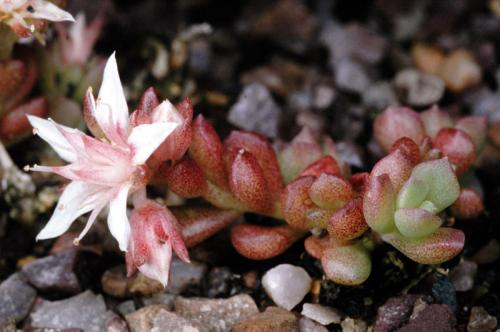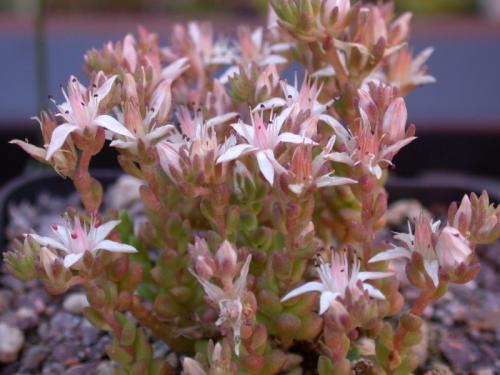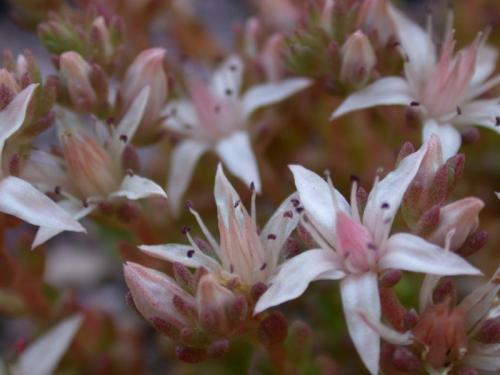NIVEUM Davidson, 1921
Synonym : Cockerellia nivea (Davidson) A.Löve & D.Löve (1985)
Distribution : Western USA (California), Mexico (Northern Baja California); quartzite soil on north slopes, 1500 -3000 m.
Description (according to 't Hart & Bleij in IHSP, 2003) :
Glabrous perennial herbs with tuberous tufted roots and repent branched frutescent primary stems, which produce rosettes.
Leaves alternate, obovate to oblanceolate, rounded or obtuse, papillose, tip bluntly submucronate, subterete, sessile, 6 - 10 x 2,2 - 4,2 mm, dark green to yellow-green, speckled with red.
Inflorescences : Flowering branches erect or ascending, ± 2,5 cm, inflorescences cymes with 1 - 3 branches, bracts leaf-like but smaller, pedicels to 1 mm.
FIowers 5- (to 8-) merous, sepals basally free, very unequal, lanceolate, oblong-lanceolate or oblanceolate-elliptic, acute to obtuse, sometimes papillose, 4,4 - 7,2 x 1,2 - 1,7 mm, divergent or suberect, petals basally slightly connate, lanceolate, acute, with a mucronate appendage, white, streaked with pink, ± 7 mm, basal 1/3 erect, then widely divergent, frequently forked, filaments white, streaked with red, anthers dark red.
Cytology : 2n = 32, ±128
Ray Stephenson (Sedum, Cultivated Stonecrops, 1994, pp 203 - 204) :
Sedum niveum is difficult to grow. It has never been happy in cultivation in Northumberland, but at least one continental botanic garden grows it. Plants may be in cultivation in the United States, but I know of no enthusiast there who claims to grow the species. Like S. debile and S. borschii, S. niveum is a diminutive alpine, but its white flowers immediately distinguish it from the other two species. From a fleshy rootstock, tiny rosettes form, each with alternate flat, fairly pointed leaves that elongate, and from creeping stems, short inflorescences rise with rounder leaves (Leaf shapes, fig. 5i). Plants rarely attain 5 cm (2 in) in height when in flower, and at other times are almost level with the ground. Closely related to, and vegetatively somewhat similar to S. cockerellii, S. niveum does not die back completely in winter.
Habitat : This stonecrop is a true alpine from inland ranges of southern California, New York, San Bernadino, and Santa Rosa Mountains. Colonies in Baja California, Mexico, are at elevations of up to almost 3000 m (10 000 ft) on quartz and in fairly moist, north-facing, shady rock ledges.
Main points of distinction : The extremely diminutive nature of flat-leaved, glabrous-green rosettes rising from creeping stems on tuberous roots makes identification fairly straightforward. Short inflorescences of white flowers with petals splashed red complete a unique combination of features. Orthocarpic flowers are stellate, but petals are slightly fused and erect at the base. Sepals are unequal.
Variation : Clausen (1975) reported that freak flowers are commonly encountered with forked or extra petals and stamens. Disjunct sites have cytological variations. Uhl (1985) reported n = 16 for U.S. plants, but n = 64 (octoploids) for Mexican plants. Despite the 200-km (100-mi) dislocation in the range of this species, Clausen (1981) claimed there were only small genetic differences both within and between populations.
Horticulture : This species dislikes sunny greenhouse conditions and wet summer periods. It appears to need special attention, so it is a real challenge to alpine specialists. Its diminutive nature makes it potentially desirable.

Sedum niveum, an extremely diminutive alpine, produces flat-leaved, glabrous-green rosettes on creeping stems.
Photo Ray Stephenson


Photos Meinolf Stützer